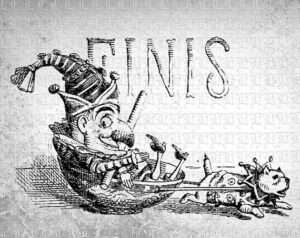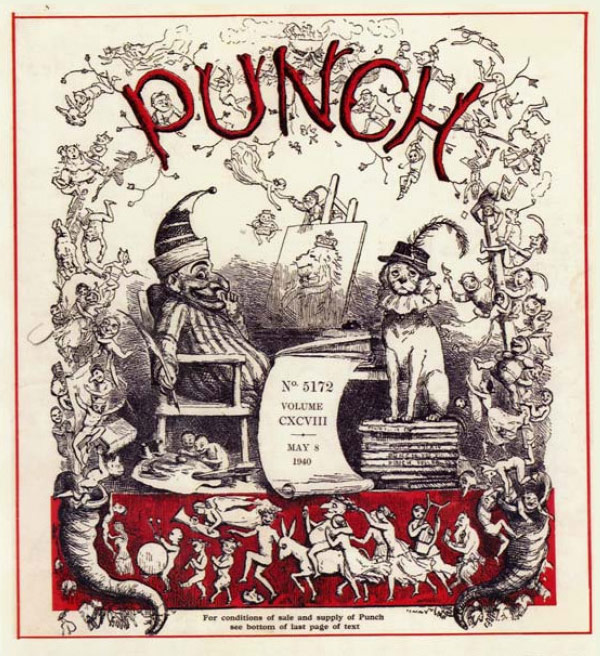The article below was first printed in the College book Mr. Punch’s Progress, published in 1987 at the time of the gala celebrations in Covent Garden to mark Mr. Punch’s 325th ‘official birthday’. It is a re-telling from academic sources, so if you want the in-depth story you are directed to the books listed at the end of the article. (Not all of Punch’s historians agree about everything – particularly on why he turned from being a string puppet to being a hand puppet). This article only tells you of Punch’s history in Great Britain. Before that he was a character in the Italian Commedia Dell’ Arte with a lineage argued back to the ancient Romans and Greeks. He is a a manifestation of the Lord of Misrule and Trickster figures found in most cultures. The picture is a detail from Benjamin Haydon’s famous painting of 1829 ‘Punch, or May Day’.
With his wicked grin and beaky nose Mr. Punch is known round the world, making him the most famous puppet character of all time. His unique career as a street entertainer is now in its fourth century and still his impish antics are as popular as ever. His comic irreverence gave ‘PUNCH’ magazine its title. His anarchic vitality has inspired opera, ballet and punk rock and his enduring popularity has seen his likeness on goods ranging from Victorian silverware to computer video games.
The rollicking red nosed old rascal was first seen in England when the Merry Monarch, Charles II, came to the throne and the good times rolled again after the grim rule of Oliver Crornwell’s Puritan followers. Gone were entertainment’s dark days when fun was held to be sinful and the theatres were shut down. Revelry was once more in fashion and the public’s taste was all for amusement and novelty. Following on the heels of the King’s triumphant return from exile in Europe came all manner of traveling showmen looking to make a good profit from catering to a fun-starved nation. Among them was Pietro Gimonde a puppet player from Italy known to his public as ‘Signor Bologna’. The cast of his show included a raucous, irreverent hunchback with a pot belly and a wicked sense of humor. His was Pulcinelia – or, in the spell-as-you-please manner of the day, Pollicinella, Polichinello and Punchinanello. Whatever the spelling, though, in the mouths of his British audience he was called Punchinello – and eventually simply Mr. Punch!
From his first appearance in England he was a hit with the general public and nobility alike. Mr. Punch so tickled the fancy of that prominent citizen Samuel Pepys that he is mentioned a number of times in his celebrated diary. The first of these was on May 9th, 1662, recording that he had been ‘mighty pleased’ by an Italian puppet show near St. Paul’s Church in London’s Covent Garden, and it is from this entry that Mr. Punch’s ‘birthday’ is now traditionally calculated by today’s Punch and Judy community. It is quite feasible, of course, that Pulcinella was in the country sorne tirne before that date but until any written evidence of an earlier sighting comes to light it is Pepys who will be popularly credited as ‘the man who discovered Mr. Punch’.
Not that Pepys would recognize today’s ‘traditional’ Punch and Judy Show anyway. The performances he saw took place inside a small tent rather like the booth of a fairground side show and Pulcinella was a marionette dancing while the showman pulled his strings. The pugnacious little stick-wielding glove puppet that we know as Mr. Punch, king of the castle in his own little gaily coloured street corner stage, developed later – a survivor who rose triumphantly from the ashes of disaster when the elaborately staged marionette performances finally lost their appeal after a century or so and no longer drew the paying crowds.
Punchinello has never lacked for friends. A short time after Pepys first noticed him he had performed in front of the King himself. The first of a number of appearances that he has made before royalty down the centuries. Sixteen monarchs have reigned in Britain since Mr. Punch first cut a caper and the rascally old entertainer has pleased princes and paupers throughout all that time. His original wooden co-stars have long since gone to he replaced by fresh painted faces but after three and a half centuries on the street Mr. Punch is still a flourishing impresario.
His heyday as a manic marionette was from the time of Charles II and Nell Gwyn (another character plucked from the streets of Covent Garden to amuse the King) to the long reign of George III a century later. During that hundred years he traveled the length and breadth of the country, dancing to the tune of the numerous showmen exhibiting this star turn who’s irrepressible nature and comic intrusions into their repertoire of puppet plays brought him nationwide glory as a mirth maker.
By the turn of a new century, though, the fairs were losing their popularity and marionette shows were old hat. What had once pleased Great Grand Papa and Mama was no longer a novelty. Like today’s long running TV series that outstay their welcome the ideas were no longer fresh. Something new was needed – and Mr Punch rose to the challenge. Whoever was the first performer to take this bold step we don’t know, but it was an idea both breathtakingly simple and born out of strict economic necessity. By cutting Mr Punch’s strings and making him a glove puppet, with a supporting cast of other glove puppets, a cumbersome traveling marionette theatre needing some half a dozen of assistants became, at a stroke, a one-puppeteer show in a theatre so simple it could he pushed on a hand cart. The street Punch and Judy Show was born. And Mr Punch was an overnight success once again.
His new form gave him speed instead of grace, the superb comic timing that only comes when one performer controls the entire cast and, above all, the glove puppet’s ability to pick things up and hold them. Looking around for something to grab, Mr Punch seized on a traditional theatrical prop – the slapstick. This is a device made from two pieces of wood which literally slap together to produce an extra loud noise when striking an object (or person!) quite gently. In the hands of clowns and their like it has a long and honorable tradition lending it’s name in modern times to an entire style of broad comedy. Scaled down to puppet size it became Mr Punch’s trademark as he laid about one and all with anarchic vitality. The show was, indeed, a hit.
The plot of this new performance varied, just as Punch the marionette had performed in different plays, but within a few years one version of the show prevailed to become the model for all Punch and Judy Shows from that day to this. To some this may seem a shame for with just the one plot Punch is restricted to forever repeating the same pattern. What it lost in diversity, however, it gained in concentrated power and Mr Punch’s tale of marital strife, of kicking over the traces and of defeating the authorities sent to bring him to justice (including defeating Old Nick himself) tapped a deep vein of popular approval. Psychologists, historians and academics have speculated a great deal on just what subconscious longings this squawking, hump backed, hook nosed, stick wielding anarchist represents, as he cuts a comic swathe through his universe, but from a performer’s point of view the question of what Mr. Punch stands for is a simpler one to answer. Mr Punch won’t stand for anything!
Like the plot of a pantomime or well-known fairy tale, the bare story of the show tells you nothing about the performance. The appeal of the Punch and Judy Show lies in the skill of the performer: part story teller, part puppeteer, part comedian, wholly an entertainer; and during the 1800’s a succession of rugged individuals made Mr Punch a familiar sight at street corners throughout the land. In their hands they weaved a riotous knockabout spectacle, taking in topical jokes, street satire, guest heroes and villains, musical interludes, and novelty specialty acts – all paid for by collecting pennies from their public.
When the railways brought travel to the masses and took town crowds to the seaside Mr. Punch went too, making himself part of traditional beach fun along with sand castles, paddling and donkey rides. He went indoors as well, for Victorian nurseries thronged with the large families popular at that time, and Mr Punch – suitably pruned of some of his grosser excesses – was deemed a colourfully suitable entertainment for the young. This suited the performer’s purse, for Papa’s pocket was more generous than that of street corner crowds and working indoors was an improvement on braving Britains’ uncertain. As a result Mr. Punch, ever adept at surviving, improved his skills as a children’s entertainer and, as society moved into the complexities of the 20th Century he found in their untutored behavior the unsophisticated emotions of a simpler age, and so his kingdom today is mainly the young. Not that adults scorn Mr. Punch, though, for a skillfully presented performance still mesmerizes any who see it. But part of its charm for those who have lost their childhood is the memories it stirs of their more innocent days. You’ll find Punch and Judy at children’s birthday parties, at Christmas jollifications and near the swings, roundabouts and bouncy castles of village fetes and other local festivities. A few hardy souls still busk the streets and shopping precincts and a few more keep golden memories of seaside Punch and Judy shows alive on the Summer beaches. Occasionally, too, Punch pokes his nose in at the door of hallowed cultural institutions, bringing a whiff of the streets into the foyer of the National Theatre for instance. A few performers have consciously bawdy shows geared for the non-family audience, and a few puppeteers will try their hand at giving the tale of Punch a deliberately modern slant. He has undergone many changes since his puppet-on-a-string days as Pulcinella, and no-one can foretell in what guise he will emerge from the 21st Century. What is certain, though, is the indestructible popular appeal of the wooden headed anarchist who’s antics are regarded as suitable entertainment for children. He’s heading into a new Millennium with all the energy intact that has carried him from the 17th Century to today in a triumphal progress worth boasting about. And boast about it he certainly does! Who wouldn’t?

Punch in a teacup towed by Toby. Always tea time!
Further reading: George Speaight Punch & Judy: a history Studio Vista Ltd. 1970; Michael Byrom Punch & Judy: its origin and evolution Shiva Publications 1972 (Revised edition: DaSilva Puppet Books 1988); Robert Leach The Punch & Judy Show: history, tradition and meaning Batsford 1985 (Some of these are out of print, but check the College Shop page at Punch & Judy Today > What is The College > College shop)

